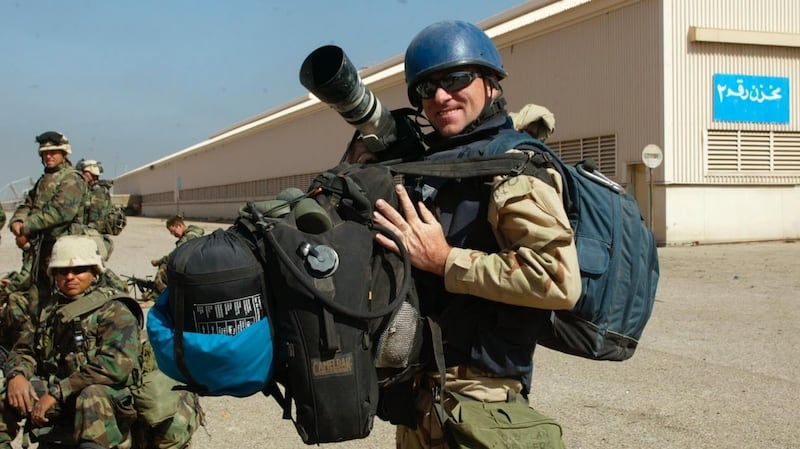You may have seen his photograph, which featured as one of the photos of the day on various news websites last weekend. It was Desmond Boylan's shot of a worker fitting a wooden arm on to a statue of Christ during the construction of an altar on which Pope Francis was to say Mass in Cuba last Sunday.
Like most photographs – well, good ones, at any rate – it is worth a thousand words. The Catholic Church’s testy relationship with the Cuban government, which maintained the country as an official atheist state for decades, is a long story.
Boylan’s photograph, of a temporary statue of Christ being assembled for a rare papal visit, captured the church’s uncertain status in Cuba.

On the eve of the pope's arrival, New Orleans-based journalist Jason Berry wrote an insightful article, published in the Atlantic magazine, on the history of Catholicism in Cuba.
The article referred to another statue, of Santo Tomás de Villanueva, which stood outside the chapel of the university in Havana that is named after the saint.
When Fidel Castro’s revolutionaries swept to power in 1959, they seized church properties. Someone decapitated the head of the saint’s statue, which served as a metaphor for the fate that befell the church under Castro. But last year, Berry wrote, the government quietly returned the Villanueva statue and chapel to the church, along with other properties.
Busy street
There’s another piece of stone that marks another connection, this one between Ireland and Cuba. On Calle O’Reilly, a busy street cutting through
Habana Vieja
(Old Havana), there’s a plaque to Alejandro O’Reilly, born Alexander O’Reilly in Baltrasna, Co Meath, in 1722.
“Two island peoples in the same sea of struggle and hope,” reads the sign in three languages – Spanish, Irish and English – with the name “Sráid Uí Raigheallaí” second under the street’s Spanish name.
One of Ireland’s “wild geese”, O’Reilly left Irish shores to fight for the Catholic armies of Europe. His father, Thomas O’Reilly, was a lieutenant in Reilly’s Dragoons, a brigade of the Spanish army.
O’Reilly the son is said to have been a Spanish infantry cadet at the tender age of 10. He rose through the ranks of the Spanish military and was sent to Havana to find out why the city’s defences did not hold up against invasion by the British forces who besieged and occupied the city towards the end of the Seven Years War in 1762.
He spent long periods in the city, save for when he was sent by Spain to Puerto Rico to organise a militia in 1764, to quell riots in Madrid in 1765 and to put manners on rebel French colonists in 1769 as the second Spanish governor of Louisiana. His exploits there earned him a fierce reputation as "Bloody O'Reilly".
There are other Irish connections in Havana, such as the Hotel Palacio O’Farrill, a hotel named after Don José Ricardo O’Farrill, the great-grandson of emigrants from Co Longford. The O’Farrills made their fortune trading in sugar and slaves in Cuba, a bustling slave-trading outpost.
Old or new, Cubans are proud of the connections with Ireland. Both island countries, they have had difficult histories with large next-door neighbours and have tried to break free violently from their colonial masters.
“Cubans are very well educated,” says photographer Boylan, a resident of the Verdado neighbourhood of Cuba. “They know Ireland, and will ask you as soon as you tell them: are you from the North or South?
“They know the history, back to [Michael] Collins. Cubans consider themselves rebels, and they consider the Irish rebels too.”
Boylan, the son of Dublin parents, grew up in Spain. He was posted to Cuba by the news agency Reuters in 2009. He worked for the agency for 21 years and now shoots for Associated Press and other news outlets. (Some of his photographs appear in today’s Weekend Review section.)
Chance encounter
His connection with Cuba goes back to a chance encounter with
Fidel Castro
in the early 1990s when he was photographing an event in South Africa. He found himself near Castro at the airport.
“I waited for his bodyguards to relax in that area,” he said. “At a distance, I said, ‘Hello, commander’, in Spanish. He lifted his head and said: ‘Somebody speaks Spain here.’”
Castro walked over to him and asked where he was from. Ireland, says Boylan.
“How do you speak Spanish?” Castro asked.
“I live in Spain,” Boylan replied.
“Have you ever been to Cuba?” Castro asked.
“No, but after meeting you, I am going there,” he replied.
“Yes, yes, you should,” he said.
At that, Boylan gave Castro his camera and asked him to take a photograph. With another camera, he photographed Castro taking the photograph of him. It’s a photograph that Boylan is very proud of.
The following year Boylan travelled to Cuba for a visit, and met his wife, Gloria. Since then, the couple have had an Irish-Cuban son, Michael, a teenager with a gift for languages, thanks to his father’s globetrotting exploits as a war photographer. And such is the way the Boylans have followed a centuries-old route from Ireland to Cuba.









